Leto
Overview
Leto, sometimes still known by her Latin name Latona, was one of the daughters of the Titans Coeus and Phoebe. She was a lover of Zeus, with whom she mothered the radiant twins Apollo and Artemis—thus incurring the wrath of Zeus’ jealous wife Hera. According to the common tradition, Hera pursued Leto across the earth, forbidding any land from receiving the Titan once she went into labor. In the end, Leto was able to give birth to Apollo and Artemis on the floating island of Delos, which later became Apollo’s most sacred site.
Apollo and Artemis went on to join the ranks of the Twelve Olympians, and Leto herself was often said to dwell with her children on Mount Olympus. Unlike many of the other Titans, Leto was fairly important in Greek religion and had her own cult in a handful of Greek cities.
Etymology
The etymology of the name “Leto” (Greek Λητώ, translit. Lētṓ; Doric Λατώ, translit. Latṓ) is obscure. In antiquity, it was sometimes thought to derive from the goddess’s “amenable” (ἐθελήμων, ethelḗmōn) and “gentle” (λεῖον, leîon) nature.[1] But these are probably folk etymologies.
Today, scholars traditionally derive Leto’s name from the Lycian word “lada,” meaning “wife” or “spouse.” But some have argued that the name is pre-Greek in origin.[2]
Pronunciation
English
Greek
Leto Λητώ (translit. Lētō) Phonetic
IPA
[LEE-toh] /ˈli toʊ/
Alternate Names
In Rome, Leto’s name was Latinized as “Latona,” perhaps influenced by the Etruscan name “Letun.”
Titles and Epithets
Leto received a handful of epithets in ancient literature, though they were not necessarily unique to her; she shared the epithets ἠΰκομος (ēǘkomos, “lovely-haired,”), καλλιπλόκαμος (kalliplókamos, “fair-locked”), and καλλιπάρηος (kallipárēos, “fair-cheeked”) with many other goddesses and beautiful mortals.
Hesiod, more uniquely (and more obscurely), referred to Leto as κυανόπεπλος (kyanópeplos, “dark-robed”).[3]
Attributes
Leto was a maternal figure, known chiefly as the mother of Apollo and Artemis. The poet Hesiod described her as “always mild, kind to men and to the deathless gods, mild from the beginning, gentlest in all Olympus.”[4]
In this maternal and mild capacity, Leto was closely associated with healing, childcare, initiation and initiation rituals, and marriage. She was most commonly depicted in a kind of triad with her children, Apollo and Artemis. Like her Olympian twins, Leto dwelled on Mount Olympus, where she was sometimes represented as one of Zeus’ most important consorts (despite the fact that Zeus was Hera’s husband).[5]
In cult and myth, Leto had several symbols. These included the spindle[6] as well as sacred animals such as the wolf,[7] the rooster,[8] and the ichneumon (an Egyptian animal that resembled a weasel or mongoose and hunted crocodile eggs).[9]
In ancient art, Leto was typically pictured as a beautiful goddess, modestly robed or veiled and sometimes riding in a chariot. She was most often depicted in the company of her children, Apollo and Artemis.[10]
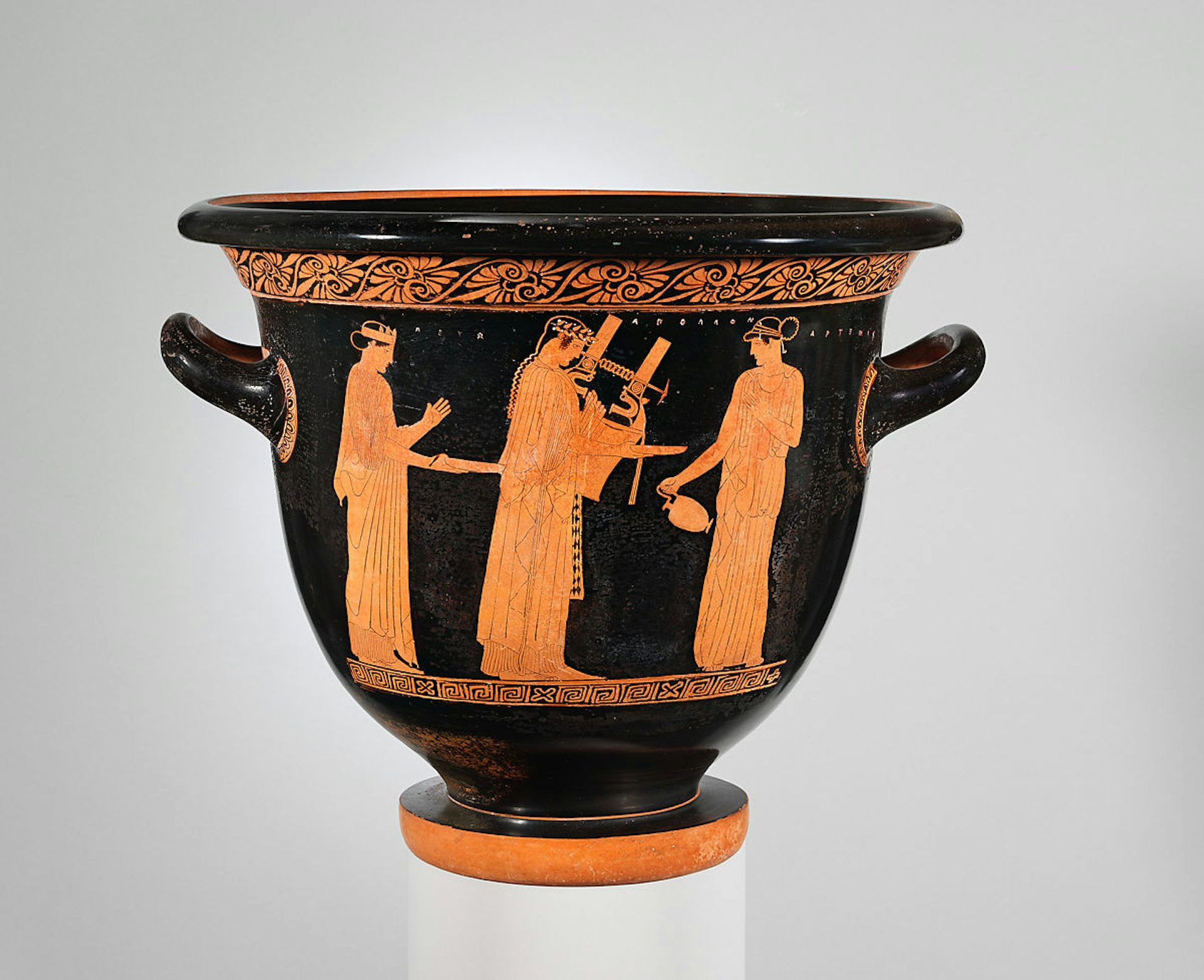
Terracotta bell-krater showing Leto (left) with her children Apollo (center) and Artemis (right). Attributed to the Villa Giulia Painter (ca. 460–450 BCE).
Metropolitan Museum of ArtPublic DomainFamily
Leto was the daughter of Coeus and Phoebe, two of the original twelve Titans (though Hyginus called her a daughter of Polus).[11] Her sister was Asteria, the mother of Hecate.[12]
Leto was one of Zeus’ many lovers. Together they had Apollo and Artemis, two of the twelve Olympian gods.[13]
Family Tree
Mythology
Origins
Leto was the daughter of the Titans Coeus and Phoebe. Though her parentage is clear, her place of birth was a source of debate in antiquity: some sources said she was born on the island of Cos in the southeast Aegean,[14] while others insisted that she came from the mysterious northern land of the Hyperboreans.[15]
The Birth of Apollo and Artemis
Even though Zeus was married to his sister Hera, he had numerous lovers—including Leto. When Leto became pregnant by Zeus, she attracted the jealousy and wrath of Hera, who did everything in her power to try and prevent Leto from giving birth.
Throughout Leto’s pregnancy, Hera hounded her viciously. She threatened to destroy any person or land that harbored the poor Titan. According to some traditions, Hera sent either her son Ares[16] or the monster Python17 to pursue Leto as she wandered the earth searching for a place to give birth.
Eventually, Leto came to the tiny barren island of Delos. The island allowed Leto to give birth, but only on the condition that it be made the center of Apollo’s cult.
Leto then began her long and painful labor. According to the third Homeric Hymn, the labor lasted nine days and nights because Hera, still not satisfied, had prevented Eileithyia, the goddess of childbirth, from assisting. Eventually, Leto sent the winged goddess Iris to bribe Eileithyia for her help. As soon as Eileithyia arrived, Leto was finally able to give birth to Apollo and Artemis while grasping a palm tree.[18]
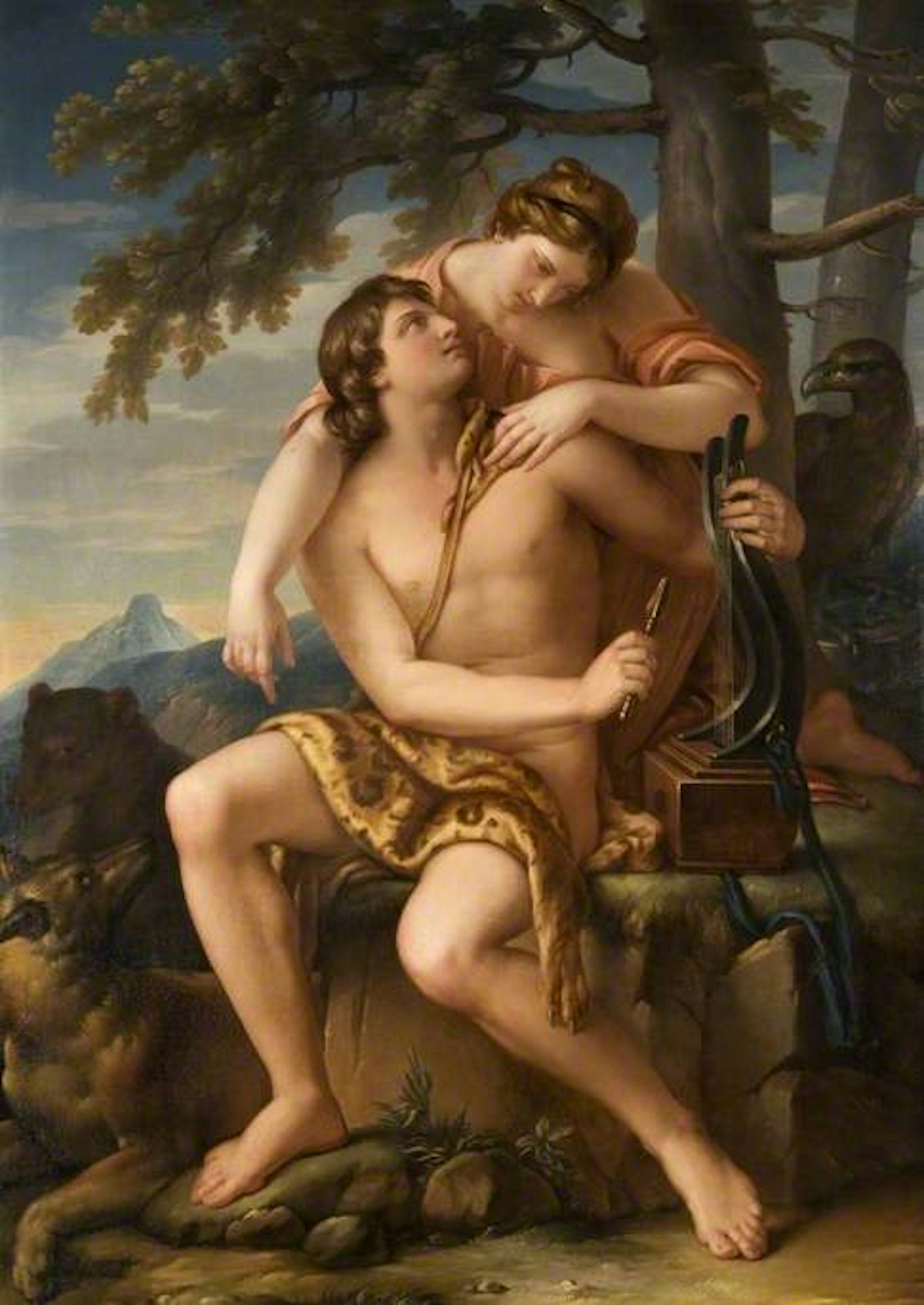
Apollo and Artemis by Gavin Hamilton (1770). Glasgow Museums, Glasgow, UK.
Wikimedia CommonsPublic DomainNumerous variations on this myth circulated in antiquity, each one adding or changing details:
According to some sources, Delos was originally a floating island. In fact, this was precisely the reason that Leto was able to give birth there: though Hera had banned any land from giving shelter to her enemy, the ban did not apply to Delos because it had no fixed location. As soon as Apollo and Artemis were born, though, Delos became rooted to its spot forever.[19]
Other traditions held that Leto came to Delos disguised as an animal. What kind of animal, however, was a matter of controversy: according to some, she arrived as a quail,[20] while others claimed that she had come from distant Hyperborea as a she-wolf.[21]
Another strangely controversial detail involved Leto’s surroundings during her labor. According to the standard account, found in the third Homeric Hymn, Leto gave birth while holding onto a palm tree (see above). But in other versions, Leto was holding an olive tree,[22] while in still others there was no tree at all; instead, she gave birth between two fountains.[23]
One tradition specified that Artemis was born before Apollo, and that she even helped her mother deliver her twin brother.[24]
In one local version of the myth, Apollo was not born in Delos at all but in Tegyra, a city located in the central Greek region of Boeotia.[25]
Other local traditions modified Artemis’ place of birth instead of Apollo’s. According to these, while Apollo was born on Delos, Artemis was born in either Ortygia[26] or Coryssus[27] in Ephesus (which housed one of Artemis’ most important ancient temples)—or, alternatively, somewhere on the island of Crete.[28]
The Wrath of Leto
Though usually regarded as a benevolent and gentle goddess, Leto had a vicious temper. A number of well-known myths (as well as some lesser-known ones ) vividly illustrate this quality.
Niobe and Her Children
In one famous myth, Leto’s fury was roused by Niobe, a queen of Thebes. Niobe had fourteen children—seven boys and seven girls. One day, she made the fatal mistake of bragging that she was more blessed than even Leto herself, for while she had fourteen beautiful children, Leto had only two.
Leto, of course, could not let this insult go unpunished and thus sent Apollo and Artemis to kill Niobe’s children. Armed with their bows, Leto’s two children proved more than a match for Niobe’s fourteen, quickly shooting down all of Niobe’s offspring (though in some versions, they left one or two survivors). Niobe wasted away from grief, more or less literally: her tears, which flowed without end, became a river, while she herself turned to stone.[29]
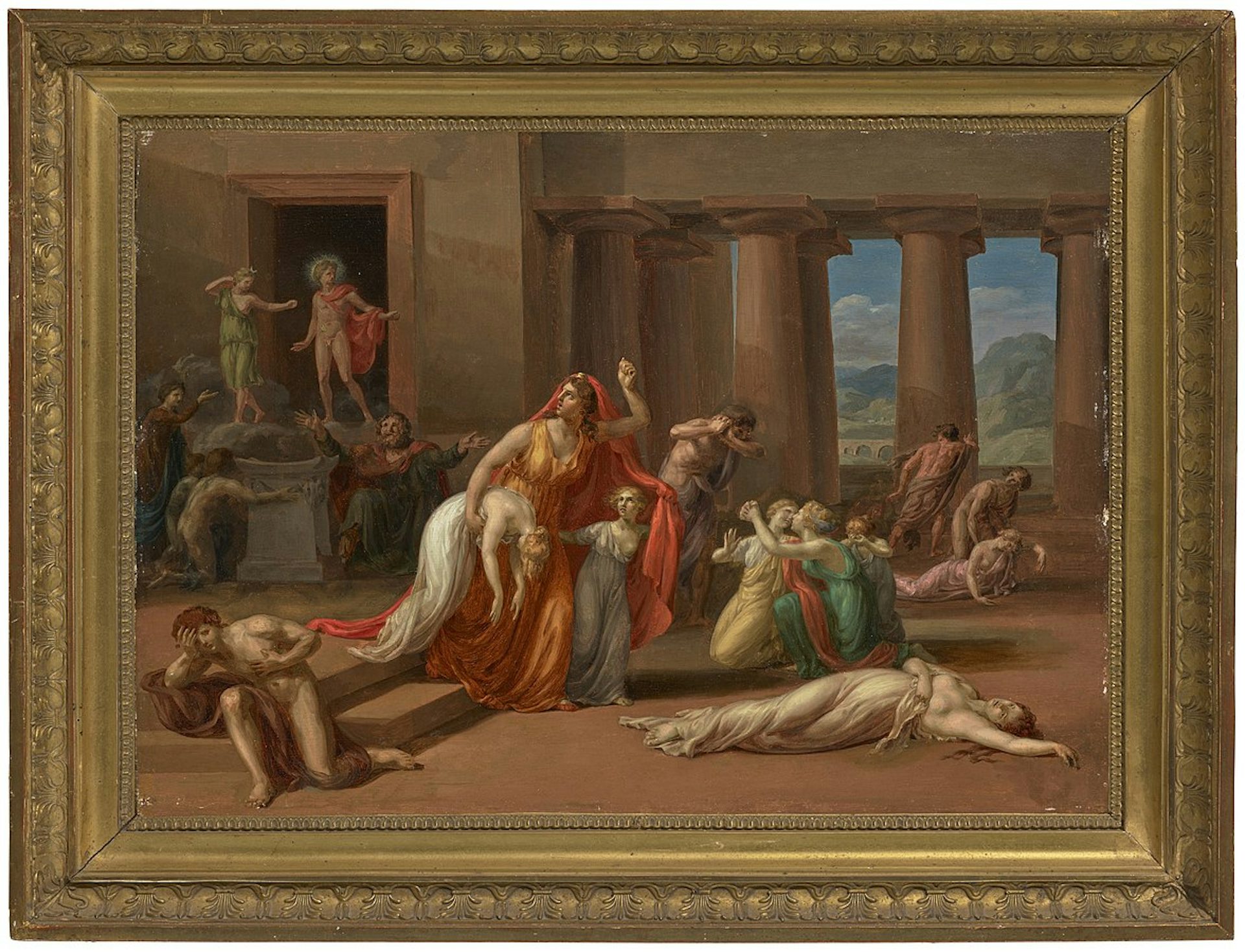
Apollo, Artemis, and Niobe by Friedrich Rehberg (19th century).
Wikimedia CommonsPublic DomainTityus
At another time, a monster named Tityus tried to rape the beautiful Leto. Though there are different versions of what happened next, all agree that Tityus’ act of hubris did not end well for him. In what is probably the most familiar tradition, Tityus was killed by one or both of Leto’s children.[30] But there were other accounts in which Tityus was killed by Zeus[31] or, alternatively, by Leto herself.[32]
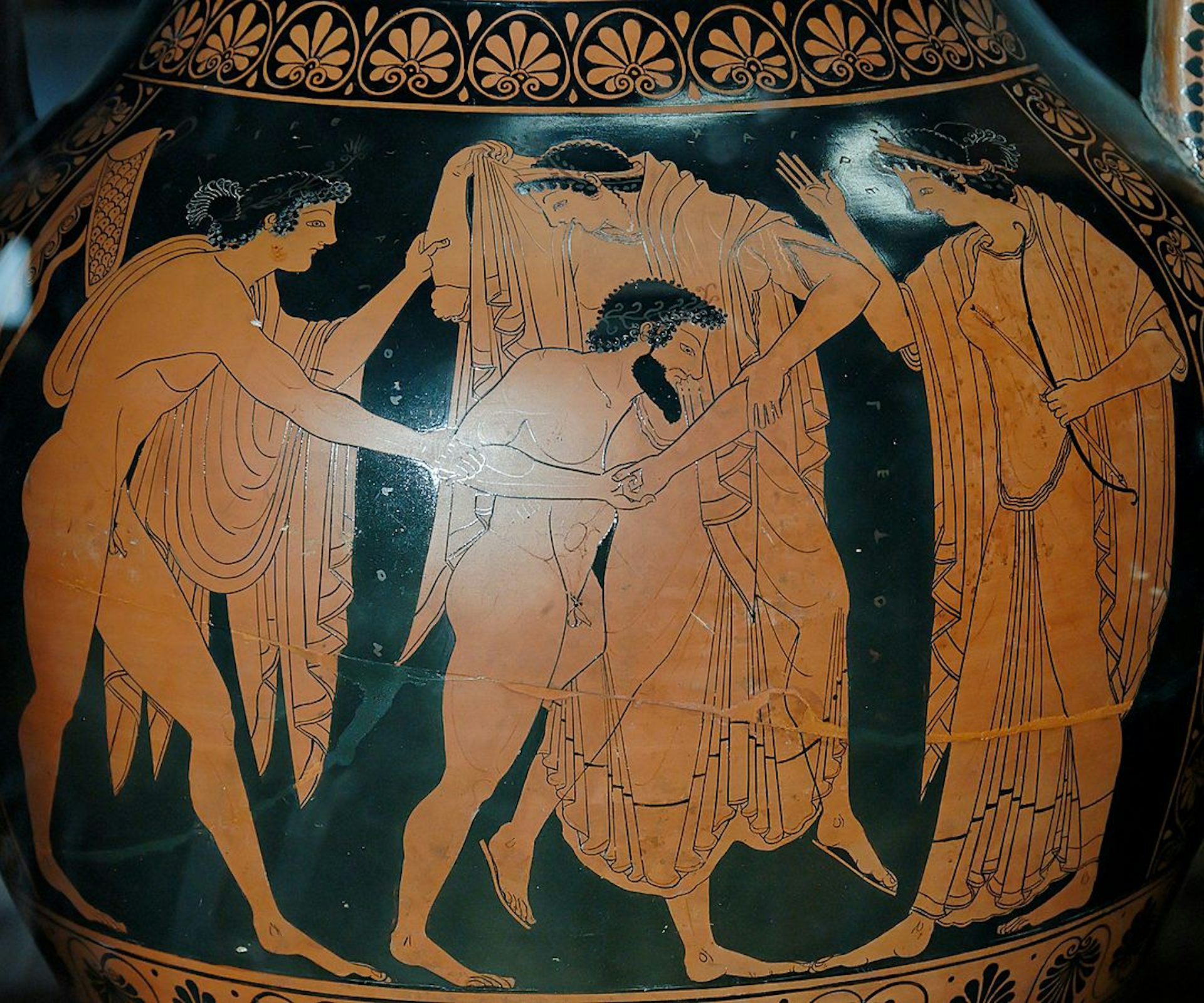
Attic red-figure amphora showing Tityus attempting to carry off Leto as Apollo and Artemis try to stop him. Attributed to Phintias (ca. 515 BCE). From Vulci. Louvre Museum, Paris, France.
JastrowPublic DomainThe Frogs of Lycia
In another myth, Leto stopped to rest somewhere in Lycia soon after giving birth to her twins. But a group of ignorant herdsmen prevented her from drinking from a spring. Leto promptly punished them by turning them into frogs.[33]
Other Myths
Leto featured in a handful of other myths.
Ovid, for example, knew of a tradition in which the hunter Orion rescued Leto and her children from a giant scorpion unleashed by Gaia, the goddess of the earth. Though this act cost Orion his own life, Leto rewarded his bravery by turning him into a constellation.[34]
During the decade-long Trojan War, Leto was among the gods who favored the doomed Trojans. In this, Leto’s interests were characteristically aligned with those of her children, Apollo and Artemis. In one scene from Homer’s Iliad, Leto helps Artemis heal the wounded Trojan hero Aeneas.[35]
Leto often appeared in the background of her children’s mythologies as well. After Zeus struck down Apollo’s son Asclepius with a lightning bolt, Apollo, in a fit of rage, killed the Cyclopes who had fashioned the lightning. Zeus wanted to cast Apollo into Tartarus for this crime, but Leto convinced him to be merciful. He ultimately decided on a lighter punishment, making Apollo serve the mortal Admetus for one year.[36]
The gentle Leto also interceded on behalf of other mythological sufferers. Valerius Flaccus’ Argonautica tells of how Leto, together with Apollo and Artemis, pleaded with Zeus to release Prometheus from his cruel punishment of having his liver torn out every day. Zeus relented and allowed his son Heracles to break Prometheus’ bonds.[37]
Other myths were more domestic and parochial in their scope. Antoninus Liberalis, for example, recounts the story of a Cretan couple, Galatea and Lamprus. When Galatea became pregnant, Lamprus told her that they would only keep the child if it was a boy. Alas, Galatea gave birth to a girl. Not wanting Lamprus to kill the infant, she named the girl Leucippus and passed her off as a boy. But as “Leucippus” grew up, it became increasingly difficult to conceal her sex. Galatea prayed to Leto for help, and Leto, caught in a compassionate mood, turned the maturing girl into a boy.[38]
In another myth, Leto intervened when Apollo overreacted to an unintentional slight by a Babylonian man named Clinis. This Clinis had wanted to honor Apollo by sacrificing mules to him, but was expressly forbidden from doing so. Alas, two of his sons went through with the sacrifice anyway. An enraged Apollo caused the mules to go mad and begin devouring Clinis and his family. When Leto and Artemis saw this, they took pity on Clinis. Though the mules had already consumed a few of Clinis’ sons, they were able to persuade Apollo to transform Clinis and his remaining family before they, too, were eaten by the mules.[39]
Worship
Temples
Within Greece itself, Leto’s temples were usually attached to those of Apollo or Artemis. This was the case at her most important sanctuaries in Delos and Didyma, but also at various local cult sites, including Zoster,[41] Megara,[42] Argos,[43] Mantinea,[44] Tanagra,[45] and Artemisium in Rhodes.[46]
In Asia Minor, on the other hand, Leto’s cult was more independent, and the goddess had a number of temples of her own. Probably the most important of these was the Temple of Leto—the “Letoon”—at Xanthus in Lycia (sometimes seen as Leto’s original cult site). Here, Leto was identified with an ancient local goddess and known simply as “Mistress” or “Mother.”
To explain the significance of the location, some sources said that it was at the Xanthus River that Leto bathed and drank after she gave birth to Apollo and Artemis.[47] Leto was the dominant goddess not only of this temple but apparently of the whole region; certainly by the Imperial period (31 BCE and beyond), the Letoon of Xanthus was the political and religious center of Lycia.
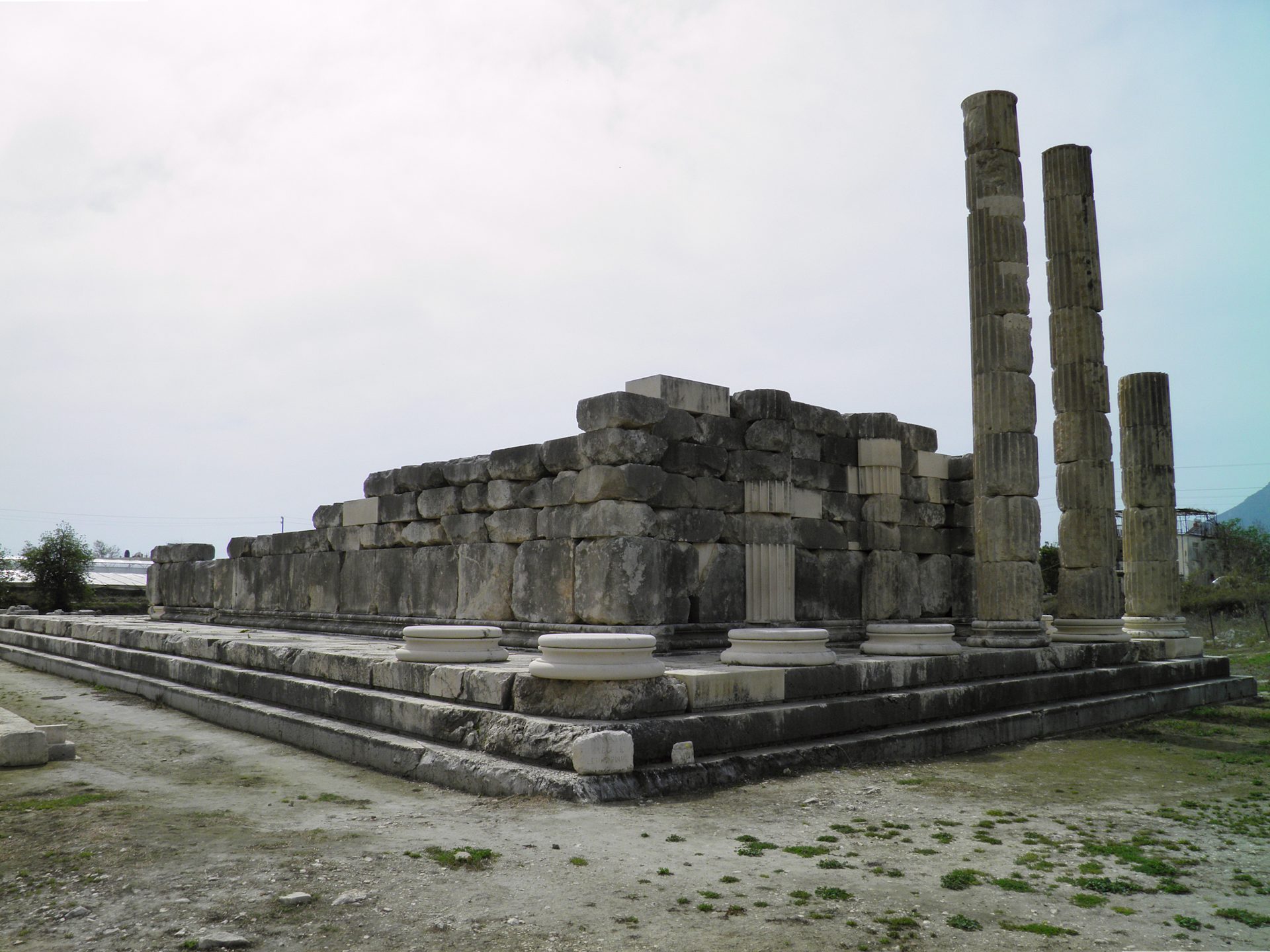
Remains of the ancient Letoon in Xanthus in Lycia (modern Antalya, Turkey).
Carole RaddatoCC BY-SA 2.0Festivals and Rituals
At many cult sites, including Delphi, Leto shared festivals with Apollo and Artemis. In parts of Asia Minor, where Leto was able to emerge from the shadow of her more radiant Olympian children, some cities were known to celebrate festivals called “Letoa” in her honor.
In some places, Leto was also connected with initiation rituals. For example, at Phaestus in Crete—the town where Leto was said to have enacted a miraculous sex change (see above)—Leto was honored in the Ekdysia, an initiation ritual involving the stripping off of clothes.[48]